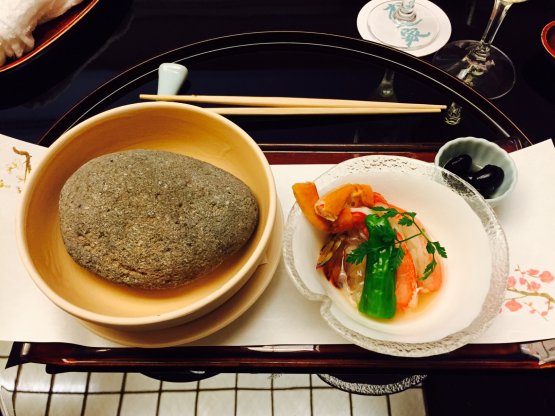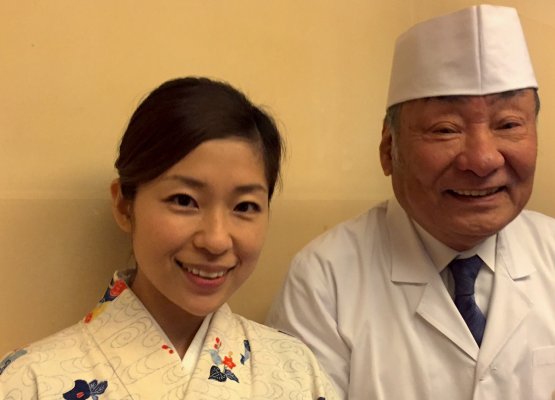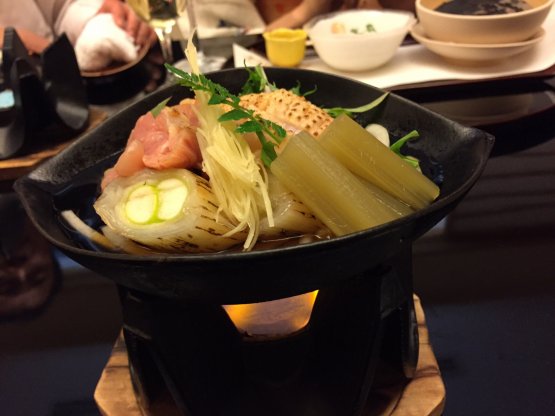When you arrive in Kobe you’re surprised because instead of a herd of wagyū steer roaming freely in the fields, you see one and a half million people grazing in the airy streets of a modern and laid-back town. Many work in the steel industry and in order to win alienation, they play golf on greens closed by huge nets standing out against factories and orbital roads. They climb between the smoke of the chimneystacks, swirling thanks to the breeze coming from the sea. The rush hour is hardly in a rush: people move in a composed way, there’s a calm atmosphere set by the sweet green hills of the prefecture of Hyogo behind and the huge port looking onto the Pacific Ocean.

A scorching Ishiyaki: the stone on the left was heated on a flame for one hour. On the small plate to the right, crab claws and marinated scampi with a base of saké and seawater. To cook them, just place them on the stone for a few seconds
In 1995 the city was devastated by a
momentous earthquake, yet some twenty years later there are no more gashes left, just those in the yellowing pictures that
Marie Udono pulls out of a drawer. Right before that, she had shown us those of
Michael Jackson and
Grace Kelly when they visited her father
Seijiro, who’s still a chef. Wearing a kimono,
Marie is the kind face at restaurant
Matsunoya. The calamity erased the restaurant opened in 1917 and forced the family to move. Yet now the setting is both simple and spectacular: seating around one hundred people in a sober way, with wood furniture over multiple rooms, on the ninth floor of the Kobe Kotsu skyscraper downtown.
Should they have bombarded you with the veneration of Japanese people for all sorts of food, you’d better confirm the prejudgement barefoot, with your feet under our
tatami, while the
Saké with pear syrup slips into the glass and a dome of ice (
kamakura) perforated by candle light hides a sea bass (
tai) sashimi. On the cold bed, there are also two leaves of
shiso and a sprig of plum flowers (
ume). We will gently brush the fish on the small soy sauce and
yuzu plate beside, in a blissful crescendo that has just begun.

Marie and Seijiro Udono, fourth and third generation at restaurant Matsunoya in Kobe, opened 99 years ago
In the
kaiseki menu, the care the chefs put in placing the chicken between the vegetables in a
sukiyaki (saucepan on a flame) or in dipping the
shijtake mushrooms and the
somen noodles on the base of the soup (
nabe) is the same they had when they had handed you their business card with a bow, holding it tight between two thumbs and two index fingers: they want to make sure the meeting will leave you with something, a trace that goes deep, a heritage that no whiff of wind could ever blow away.
There are many signs, those that
Roland Barthes finely noted, seeds of tastings built around the local ingredients of Hyogo, a province that has been working for millennia on raw materials we had difficulty imagining:
Asakura sansho (a wonderful raw pepper with anaesthetic citrus notes), white and red
miso,
Adzuki red beans, the very sweet onions from the island of
Awaji with a sesame sauce brushed on top, Chinese cabbage, whitebait marinated in soy sauce.

Sukiyaki (saucepan on a flame) with chicken, onion, vegetables and mirin (sweet saké)
Tokyo is far enough (over 500 km) so as to keep unauthentic trends to a distance. And so as to serve a
tenpura made as in the dawn of times: lotus,
shiitake mushrooms, asparagus and conger with a batter of icy water, flour and eggs; sesame and cotton oil sizzle in the pan in front of the table, the food is shocked in the pan just a little before becoming golden. How delicious.
With two soups to close, we are brought back to tomorrow: a cold soup with duck roast, tuna bottarga, yuzu and somen and a scorching one made with
miso, an essential ingredient in the traditional Japanese grammar. We’ll continue tomorrow.
1. to be continued